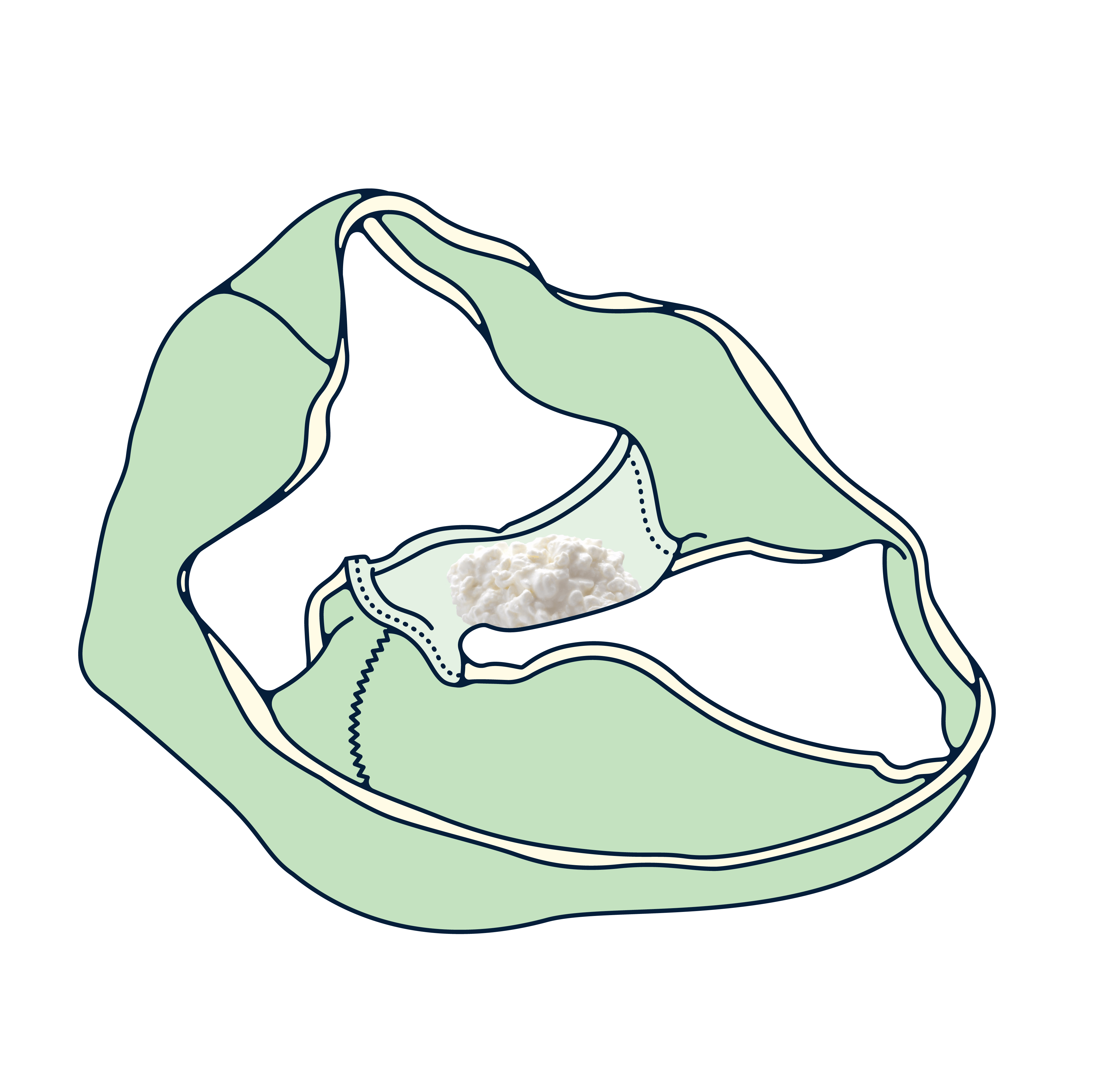Illustrated by Erin Rommel
Bacterial vaginosis (BV) and thrush (vaginal candidiasis) are two very common causes of unusual vaginal discharge. They’re mostly harmless, but annoying AF to have.
Both BV and thrush are caused by an imbalance in your vaginal microbiome and vaginal pH. Your vaginal flora is made up of billions of different bacteria, the most important of which are lactobacilli, good bacteria responsible for keeping infections at bay.
How the vaginal microbiome works
Lactobacilli feed on glycogen (which your body produces) to produce hydrogen peroxide and lactic acid, which in turn help maintain an acidic pH. An acidic vaginal environment prevents bad bacteria and pathogens from over-growing and causing infections like BV and thrush. That's why a healthy vaginal pH is between 3.8 and 4.5.
Lactobacilli essentially work to ensure homeostasis in your vaginal microbiome, keeping both you and your vagina healthy. Whenever something disrupts your vaginal microbiome, the balance of bacteria is overthrown and infection-causing agents can take over.
Your vaginal microbiome can be disrupted by several internal and external factors (like your menstrual cycle, antibiotics, sex and feminine hygiene products). Although there are different things you can do to keep your vaginal microbiome healthy, sometimes disruptors are out of your control.

When your vaginal flora is disrupted, you’re at greater risk of developing infections like thrush and BV. Daye's ProViotics strengthen your vaginal microbiome by supplying it with 2.5 billion live cells of Lactobacillus plantarum GLP3.


What causes bacterial vaginosis (BV)?
If you’ve ever had BV, you’re not alone: around 1 in 3 vagina owners will get BV at some point in their lives. In fact, it’s the most common cause of unusual vaginal discharge. Luckily, it’s nothing more than a (smelly) annoyance.
The most common causes include:
Bacterial overgrowth
Although a strain of bacteria called Gardnerella vaginalis is commonly associated with BV, it rarely acts alone. BV happens when there is an overgrowth of anaerobic bacteria (bacteria that can grow without oxygen) that outnumber the lactobacilli in your vagina.
Your menstrual cycle
It’s fairly common for BV to show up cyclically during or after your period. Menstrual blood has a slightly alkaline pH (around 7.4), so prolonged or irregular bleeding patterns could potentially cause the vaginal pH to be less acidic.
Sexual intercourse
Other risk factors of BV are unprotected sex, since semen has an alkaline pH. People with penises might not be able to get BV, but they can be carriers of it. This means that they can easily pass it on to their female sexual partners. Talk about double standards, eh? Women in same-sex relationships can also pass BV to their partners, FYI!�
Douching and vaginal washes
Vaginal washes and douches flush away lactobacilli, making it easier for harmful pathogens to colonise. One study even found that women who used vaginal douche users were more likely to report having BV.
Smoking cigarettes
Smoking increases your risk of BV. Doctors aren’t really sure why, but it’s not like you needed another reason to quit smoking anyway.
Bad luck
Then there’s the fact that some people are simply predisposed to refractory BV, and unfortunately there’s not much you can do to fully avoid it from showing up again. Fun!
Symptoms of BV
The most common symptom of BV is thin, watery vaginal discharge that is white or grey in colour, and has a strong, foul, or fishy smell – especially after sex (though it’s not an STI).

What does BV feel like?
BV isn’t usually associated with soreness, itching or irritation. It’s not a dangerous infection, but it may increase your risk of contracting STIs (the reason for this is still unclear), so it’s important to treat as soon as possible.
How to treat BV
BV is often asymptomatic and clears up on its own, but when symptoms do show up, treatment includes an antibiotic called metronidazole. It’s also very, very important that you don’t drink alcohol while taking metronidazole (soz). You may also be prescribed vaginal creams or pessaries that restore acidity and promote the growth of lactobacilli.
Doctors aren’t entirely sure of what causes BV, so available treatments aren’t very effective over the long-term. Annoyingly, BV often comes back after treatment.

Tips to prevent BV
That doesn’t mean that you can’t reduce your risk of contracting bacterial vaginosis. If you’re at greater risk of recurring BV:
- Avoid using scented soaps, shower gels
- Use gentle detergents to wash your knickers
- Take probiotics regularly
- Take showers instead of baths
- Change your tampons/pads regularly
- Ensure that you’re wiping correctly (front to back!)
- Remove gym clothes immediately after a workout
Can BV treatment trigger thrush?
You may have heard that antibiotics can cause thrush, but that’s only true for broad-spectrum antibiotics. Antibiotics like metronidazole (which are prescribed for BV) are not known to cause thrush, but this doesn’t mean you should abuse them!
What is thrush?
BV symptoms can often get confused for vulvovaginal candidiasis (AKA a yeast infection or thrush). While BV is caused by a bacteria, thrush is caused by a yeast (a type of fungus). Treatment and symptoms will therefore differ.
What causes thrush?
Thrush is a lot more common in people with vaginas (about 3 out of 4 women will get thrush at some point). It occurs when Candida albicans (found in most people’s vaginas, as well as the skin, mouth, and intestines) a healthy yeast normally found in your body, grows out of control. Your immune system tends to keep it under control, but if the vaginal microbiome is thrown out of whack, yeast overgrowth can happen.
Like with BV, many experts believe thrush is caused by cyclical changes in the female reproductive hormones, as well as the vaginal microbiome’s pH.
You may be at higher risk if you:
- are pregnant
- have untreated diabetes
- have recently taken broad-spectrum antibiotics
- are immunosuppressed

What thrush feels like
Basically, thrush is harmless but can be uncomfortable AF. The most common symptom of thrush is a thick, white, cottage cheese-like discharge, as well as:
- burning or itching of the vulva or vagina
- a burning sensation when you pee
- uncomfortable sexual intercourse
In more severe cases, you may notice swelling and redness of the vulva or vaginal opening.
How to treat thrush
Luckily, thrush is usually easily treatable with an anti-fungal vaginal cream called clotrimazole.
You may have read online that applying live yogurt to your vulva treats thrush, but there is no evidence to back up this claim. For now, let’s stick to just eating yogurt…

Tips to prevent vaginal thrush
There aren’t any effective, long-term management options for refractory vaginal infections, and the overuse of antibiotics can do more harm than good in the long run. That’s why prevention is key.
To limit your risk factors:
- always use a condom
- wear cotton knickers (washed in gentle detergent)
- stay away from douches and vaginal washes
- wash your vulva with warm water only
- shower instead of bathing
- take high-quality probiotics
Recurrent vaginal infections might not pose much of a risk to your health, but they can interfere with your quality of life, getting in the way of your self esteem and sex life. And at the end of the day, who even has time to deal with thrush or BV on a monthly basis?
TL;DR
- Thrush and bacterial vaginosis (BV) are both common conditions that cause unhealthy vaginal discharge.
- Thrush is a yeast infection caused by the overgrowth of a fungus (commonly Candida albicans). BV, on the other hand, is a bacterial infection most commonly caused by Gardnerella vaginalis. Both thrush and BV happen when your vaginal microbiome is thrown out of whack and there is a pH imbalance.
- The most common symptom of BV is watery, grey or white discharge that has a foul or fishy smell. The most common symptom of thrush is cottage cheese-like thick and white discharge, often accompanied by burning or itching.
- BV is treated with an antibiotic called metronidazole, while thrush is treated with an anti fungal medication called clotrimazole.
- Both conditions can be refractory, and annoyingly there is no effective long-term treatment for BV or thrush.
- Prevention is key! Always use a condom, avoid over-washing your vulva with soap, don't use vaginal douches, don't smoke, and consider taking high-quality vaginal probiotics.
Say goodbye to thrush and BV... and say hello to Daye ProViotics. Daye's vegan, allergen-free good bacteria supplement has been clinically validated to support the vaginal microbiome. Available here.






